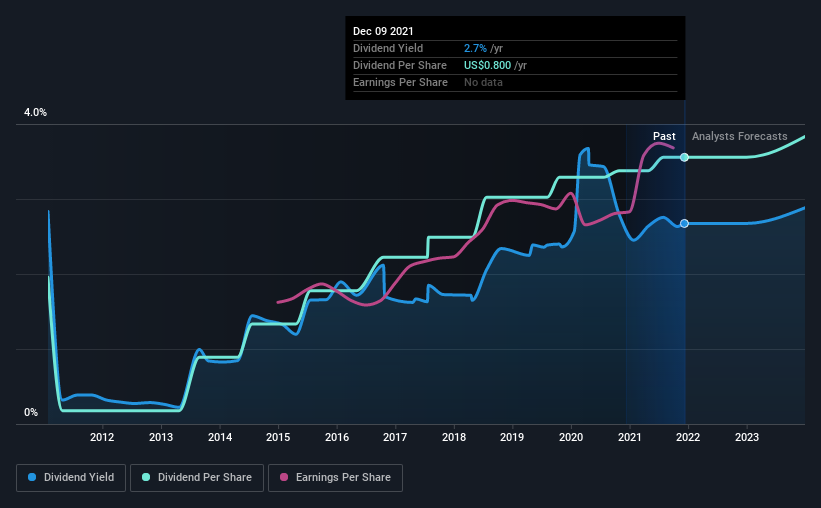
Cadence Bank (NYSE:CADE) has announced that it will be increasing its dividend on the 3rd of January to US$0.20. This takes the annual payment to 2.6% of the current stock price, which is about average for the industry.
View our latest analysis for Cadence Bank
Cadence Bank's Dividend Is Well Covered By Earnings
Solid dividend yields are great, but they only really help us if the payment is sustainable. However, prior to this announcement, Cadence Bank's dividend was comfortably covered by both cash flow and earnings. As a result, a large proportion of what it earned was being reinvested back into the business.
EPS is set to fall by 17.2% over the next 12 months. If the dividend continues along recent trends, we estimate the payout ratio could be 72%, which we consider to be quite comfortable, with most of the company's earnings left over to grow the business in the future.

Dividend Volatility
Although the company has a long dividend history, it has been cut at least once in the last 10 years. The first annual payment during the last 10 years was US$0.44 in 2011, and the most recent fiscal year payment was US$0.80. This works out to be a compound annual growth rate (CAGR) of approximately 6.2% a year over that time. We like to see dividends have grown at a reasonable rate, but with at least one substantial cut in the payments, we're not certain this dividend stock would be ideal for someone intending to live on the income.
Dividend Growth May Be Hard To Achieve
Given that the dividend has been cut in the past, we need to check if earnings are growing and if that might lead to stronger dividends in the future. Earnings has been rising at 4.0% per annum over the last five years, which admittedly is a bit slow. While EPS growth is quite low, Cadence Bank has the option to increase the payout ratio to return more cash to shareholders.
We'd also point out that Cadence Bank has issued stock equal to 88% of shares outstanding. Trying to grow the dividend when issuing new shares reminds us of the ancient Greek tale of Sisyphus - perpetually pushing a boulder uphill. Companies that consistently issue new shares are often suboptimal from a dividend perspective.
In Summary
Overall, it's great to see the dividend being raised and that it is still in a sustainable range. The payout ratio looks good, but unfortunately the company's dividend track record isn't stellar. The payment isn't stellar, but it could make a decent addition to a dividend portfolio.
Market movements attest to how highly valued a consistent dividend policy is compared to one which is more unpredictable. However, there are other things to consider for investors when analysing stock performance. Case in point: We've spotted 2 warning signs for Cadence Bank (of which 1 can't be ignored!) you should know about. Looking for more high-yielding dividend ideas? Try our curated list of strong dividend payers.
New: AI Stock Screener & Alerts
Our new AI Stock Screener scans the market every day to uncover opportunities.
• Dividend Powerhouses (3%+ Yield)
• Undervalued Small Caps with Insider Buying
• High growth Tech and AI Companies
Or build your own from over 50 metrics.
Have feedback on this article? Concerned about the content? Get in touch with us directly. Alternatively, email editorial-team (at) simplywallst.com.
This article by Simply Wall St is general in nature. We provide commentary based on historical data and analyst forecasts only using an unbiased methodology and our articles are not intended to be financial advice. It does not constitute a recommendation to buy or sell any stock, and does not take account of your objectives, or your financial situation. We aim to bring you long-term focused analysis driven by fundamental data. Note that our analysis may not factor in the latest price-sensitive company announcements or qualitative material. Simply Wall St has no position in any stocks mentioned.
About NYSE:CADE
Flawless balance sheet with reasonable growth potential and pays a dividend.


